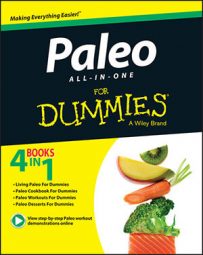Plainly, Paleo strength training is about making you strong(er). To get strong, lift heavy. You find out what heavy means shortly, but for now, just know that rarely is it anything pink or rubbery. Don’t let this intimidate you. Heavy lifting is by no means a dangerous endeavor — assuming you’re a healthy individual — unless you go about it unwisely. As with anything else, proper execution is key.
Defining strength training
Strength comes in many forms and extends far beyond the realm of hoisting weight overhead. Although working against resistance is a true test and demonstration of strength, strength is much more than that and serves a much greater purpose than simply allowing you to “lift weights.”
Here are a few of the many types of strength:
Limit or absolute strength measures the most force you can exert for a single repetition. A one-rep maximum dead lift is an example of limit strength.
Strength endurance is your ability to exert a submaximal force over a prolonged period of time. An example of strength endurance is performing push-ups for 30 to 60 seconds.
Power is your ability to exert force rapidly, such as in the jerk or the snatch.
You need to know the difference between these strength qualities. You also need to understand that increasing your limit strength will almost invariably increase your strength endurance and power output as well.
The cave man likely didn’t have any sort of planned heavy lifting routine, but he probably engaged in some heavy lifting almost every day. And that’s what sets apart the primal strength-training approach from most others. Following the primal strength approach, you do a little heavy lifting almost every day. That’s just enough to get the job done, not a smidgen more.
Strength is cumulative. Strength is more a function of volume (the total amount of work you perform) rather than a function of density (how much work you perform in a fixed period of time, such as a day, an hour, or a set). Therefore, you’ll likely get just as strong — if not the teensiest bit stronger — by performing ten reps a day spread out over seven days than by performing 70 reps all in one day.
Acknowledging the benefits of lifting heavy things
No endeavor is more profitable to the body than the effort of lifting heavy things. And make no mistake about it: Strength training is lifting heavy things. Just because you’re lifting weights doesn’t necessarily mean you’re strength training. In fact, you really don’t need any weights to train strength.
Aside from the more obvious benefits of looking good with your clothes off and enhanced athletic performance, strength training may also help prevent, reverse, or ward off the symptoms of the following malaises:
Arthritis
Back problems
Depression
Diabetes
Obesity
Osteoporosis
Being strong fixes just about everything. If you struggle with weight issues, getting stronger will help you lean out. If your athletic performance isn’t quite where you want it to be, getting stronger will certainly help you with that, too. And if you suffer frequently from injuries, additional strength will amplify your resilience.
Determining how heavy is heavy enough
To get strong, you have to lift heavy, but what exactly is heavy? Well, unfortunately, no definite number or weight can define heavy, because heavy is a relative term. What may be heavy to you may not be heavy to someone else, such as a gymnast or power lifter.
You have to define your own definition of heavy, and that definition will change as you grow stronger and stronger. The goal, therefore, should always be to make your current heavy light.
To answer the question “what is heavy?” as simply as possible, if you can lift something for more than five repetitions, it’s not heavy. So you could say that a “heavy” weight is any weight that you can move one to five times, but no more than that. If you go over five reps throughout any of the strength exercises, then you’re training something other than limit strength.
For example, the push-up may start out as a heavy strength effort, but as you become proficient at it and can perform multiple repetitions, it becomes a strength endurance effort.
The lighter the weight, the more reps you add, and the more you start venturing into strength endurance training.

